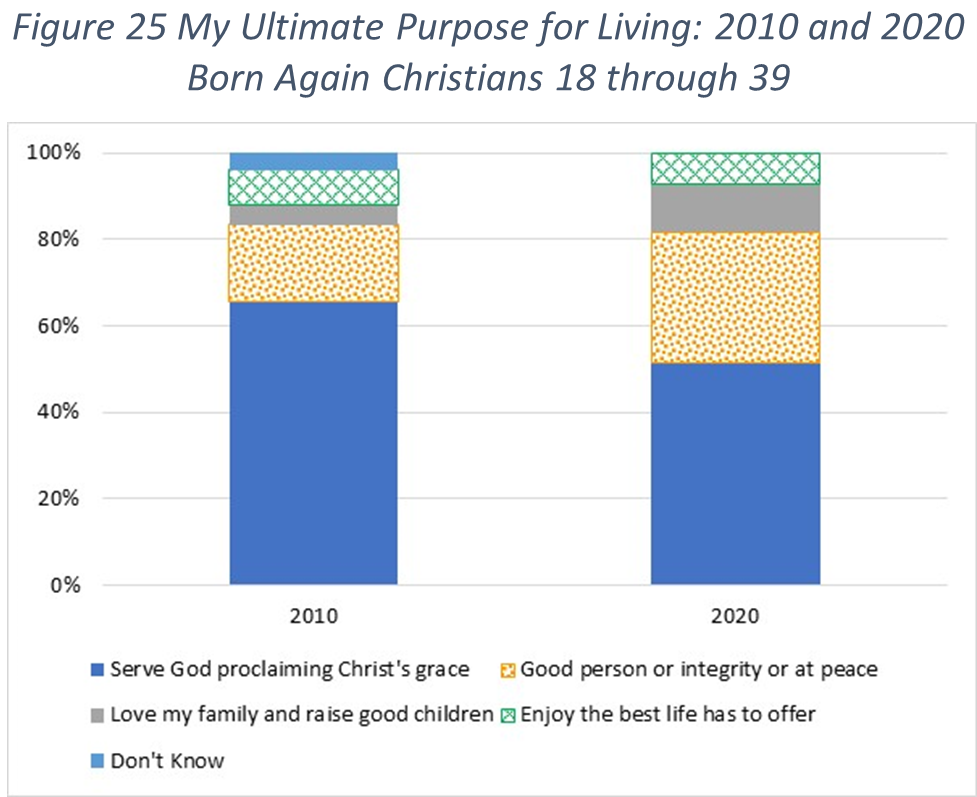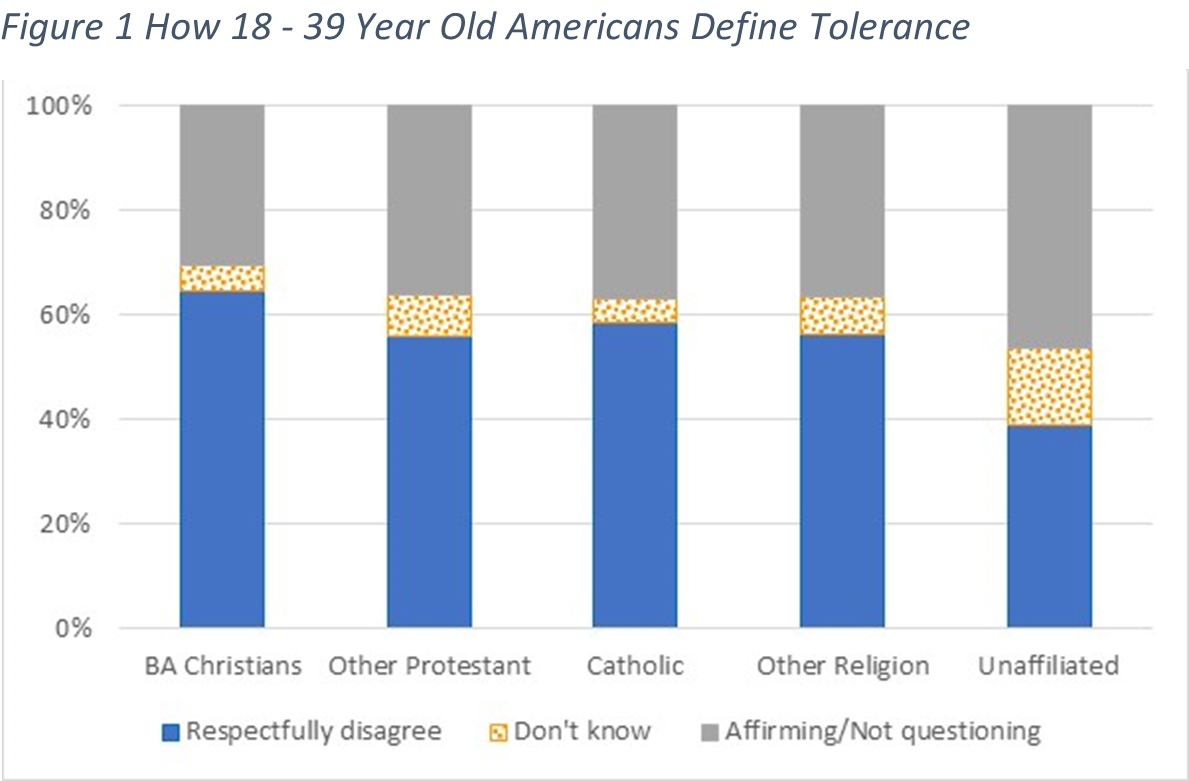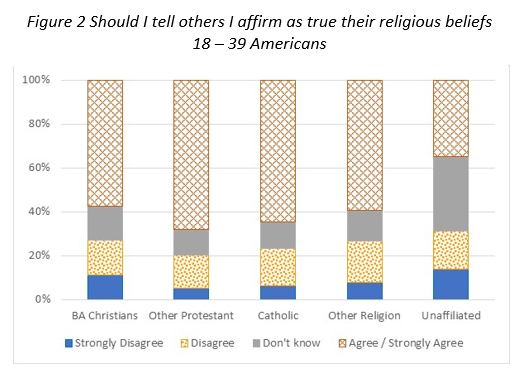In order to grow the number of Gen-Z Christians, we need an understanding of ways to build bridges from their pluralistic, secular worldview to seriously contemplating the unique grace of God. Steve Cable draws upon the wisdom of two pastors who are making a real difference in the lives of young adults to address this important topic.
What Are Gen-Zs Like?

In this article we look beyond the Millennials to consider the latest generation and what they tell us about the future of Evangelicals in America. Gen-Z is the generation born between 1995 and 2010. This year, half of the Gen-Z generation are 18 or older. By the time they are all at least 18, the Millennials and Gen-Zs will make up almost 50% of the adult population. We will consider how this generation compares with previous generations. We want to understand this generation to truly communicate the good news of the gospel to them; to help them “to walk in a manner worth of the Lord.”{1}
In their book, So the Next Generation Will Know{2}, Sean McDowell and J. Warner Wallace identified some key traits common among Gen-Zs. They are:
- Digital Multitaskers – “spending nearly every waking hour interacting with . . . digital technology,” often while watching television
- Impatient – quickly moving from thing to thing with an attention span of around 8 seconds
- Fluid – constantly blurring the lines; making truth, genders, and family structures personal choices
- Lonely – swamped in social media where personal relationships are minimized while personal troubles follow them everywhere. Sean points to “the availability of endless counterfeits that claim to be able to fill their hearts with meaning.”{3}
- Individualistic – individual feelings more important than facts while judging the choices of others is avoided. As James White points out in Meet Generation Z{4}, “the ability to find whatever they’re after without the help of intermediaries . . . has made them more independent. . . . Like no other generation before, Gen-Z faces a widening chasm between wisdom and information.”{5}
Most importantly, most of these young Americans are thoroughly secular with little exposure to Christian theology. As White opines, “They are lost. They are not simply living in and being shaped by a post-Christian cultural context. They do not even have a memory of the gospel. . . . They have endless amounts of information but little wisdom, and virtually no mentors.”{6}
As they enter adulthood, the culture around them will not encourage them to consider the claims of Christ. In fact, the Millennials going before them are already seen leaving any Christian background behind as they age into their thirties.
Gen-Z: How Are They Trending?
What can we truly know about the religious thinking of Gen-Zs age 11 to 25? Pew Research surveyed teens and their parents giving us a glimpse into both{7}.
They found one third of American teens are religiously Unaffiliated.{8} In contrast, their parents were less than one quarter Unaffiliated. Another Pew survey{9} found more than half of young adult Gen-Zs are unaffiliated. This group is easily the largest religious group among Gen-Zs.
Teens attend church services with their parents, but lag behind in other areas. Less than one fourth of teens consider religion very important. And on an absolute belief in God and praying daily, the teens trail their parents significantly.
Using an index of religious commitment{10}, almost half of the parents but only one third of teens rated high. In fact, almost half of teenagers with parents who rated high did not rate high themselves.{11}
Perhaps the minds of teenagers are mush. Their views will firm up as they age. In reality, older Gen-Zs and Millennials also trail older adults by more than 20 points in believing in God and praying daily.{12} Also, church attendance drops dramatically among these young adults who are no longer attending with parents.
If religion were important to teens, they would look to religious teaching and beliefs to help make decisions about what is right and wrong. But less than one third of teens affiliated with a religion turned to its teachings to make such decisions.
As George Barna reports,{13} “The faith gap between Millennials and their predecessors is the widest intergenerational difference identified at any time in the last seven decades.” It seems that Gen-Z will increase this gap.
Gen-Z: Worldview and Apologetics
Why have the Unaffiliated been growing dramatically over the last 25 years while doctrinally consistent Christians have been declining? At one level, we recognize the watered-down gospel taught in many churches encourages people to pursue other things and not waste time on church. That may have been the primary issue at one time. But in this decade, we are seeing a real reduction in the number of Evangelicals as well. The self-professed Evangelicals{14} among those ages 18 to 29 has reduced from 29% down to 20%, a reduction of almost one third.
One major driver is the dominant worldview of our young adult society. The worldview promoted by our schools, media, and entertainment industry has changed from a Christian inspired worldview to a worldview which is secular and specifically anti-Christian. As James White observes, “It’s simply a cultural reality that people in a post-Christian world are genuinely incredulous that anyone would think like a Christian—or at least, what it means in their minds to think like a Christian.”{15}
Almost all Gen-Zs have been brought up hearing the worldview of Scientism espoused. This worldview teaches “that all that can be known within nature is that which can be empirically verified . . . If something cannot be examined in a tangible, scientific manner, it is not simply unknowable, it is meaningless.”{16} At the same time, most Gen-Zs have not even been exposed to an Evangelical Christian worldview. Consequently, apologetics is critical for opening their minds to hear the truth of the gospel. Many of them need to understand that the basic tenets of a Christian worldview can be true before they will consider whether these tenets are true for them. Answering questions such as: “Could there be a creator of this universe?” and “Could that creator possibly be involved in this world which has so much pain and suffering?” is a starting point to opening their minds to a Christian view.
Encouraging Gen-Zs to understand the tenets of their worldview and comparing them to a Christian worldview begins the process of introducing them to the gospel. As White points out, “I have found that discussing the awe and wonder of the universe, openly raising the many questions surrounding the universe and then positing the existence of God, is one of the most valuable approaches that can be pursued.”{17} The Christian worldview is coherent, comprehensive and compelling as it explains why our world is the way it is and how its trajectory may be corrected into one that honors our Creator and lifts up people to a new level of life.
Gen-Z: Removing the Isolation of Faith
What will it take to reach Gen-Z? James White says, “. . . the primary reason Gen-Z disconnects from the church is our failure to equip them with a biblical worldview that empowers them to understand and navigate today’s culture.”{18} If we want to equip Gen-Zs to embrace faith, we must directly discuss worldview issues with them.
The challenge is exacerbated as most Gen-Zs are taught a redefined tolerance: to not only accept classmates with different worldviews, e.g. Muslims and the Unaffiliated, but to believe that it is as true for them as your parents’ worldview is for them. As Sean McDowell states, “Gen-Zs are exposed to more competing worldviews—and at an earlier age—than any generation in history.”{19}
The new tolerance leads directly to a pluralistic view of salvation. Christ stated, “No one comes to the Father except through me,”{20} and Peter preached that “There is salvation in no one else, for there is no other name under heaven . . . by which we must be saved.”{21} Yet the survey of American teens{22} finds less than one third believe that only one religion is true, broken up into two-thirds of Evangelicals and less than one-third of Mainlines and Catholics.
Compounding these issues is the growing practice of limiting the impact of religious beliefs on real life. Sean points out, “The biggest challenge in teaching worldview to young people is the way our increasingly secular culture fosters the compartmentalization of faith.”{23} We need to help them see how a consistent Christian worldview applies to all issues. It is foolish to segregate your spiritual beliefs from your life decisions.
As an example, many Gen-Zs are enamored by a socialist view that the government should provide everything we need, equally distributing goods and services to all. Those who work hard and excel will have their productivity redistributed equally. It sounds like a possibly good approach and yet it has destroyed the economies of many countries including Russia, Cuba, and Venezuela. It fails because it is based on a worldview that “assumes greed comes from inequality in the distribution of material goods in society.”{24} In contrast, the Bible is clear that greed is part of the fallenness of the human heart. As a result, any centralized function with no competition discourages productivity and becomes an inefficient bureaucracy.
Reaching Gen-Zs
Today, most Gen-Zs move into adulthood with little exposure to the gospel. The majority are either Unaffiliated, another religion, or have a nominal Christian background. Current surveys find that 98% of young Americans do not have a Christian worldview.{25}
This sobering data does not mean giving up on reaching Gen-Z. But if we are not intentional about it, we are not going to stem the tide. As James White observes, “What is killing the church today is (focusing) on keeping Christians within the church happy, well fed, and growing. The mission . . . must be about those who have not crossed the line of faith.”
And Sean McDowell points out that we need “to teach the difference between subjective and objective truth claims and make sure they understand that Christianity falls in the latter category.”{26}
Sean encourages a focus on relationships saying, “Relationships are the runway on which truth lands. Take the time to listen with empathy, monitor from a place of wisdom, and demonstrate your concern.”{27} White agrees, saying, “If we want (them) to know the faith, we have to teach, model and incarnate truth in our relationship with them.”{28} From a place of relationship, we can address challenges keeping them from truly hearing the gospel.
One key challenge is the role of media. As Sean notes, “Media shapes their beliefs, and it also shapes the orientation of their hearts.”{29} To counter this pervasive influence, he suggests engaging them in a skeptic’s blog. Help them consider 1) what claim is being made, 2) is the claim relevant if true, and 3) decide how to investigate the claim.{30} By learning to investigate claims, they are examining the truth of the gospel. We should never fear the gospel coming up short when looking for the truth.
Key ways White’s church is connecting with the Unaffiliated include:
- Rethinking evangelism around Paul’s message in Athens. Tantalizing those with no background to search for truth in Christ.
- Teaching the grace/truth dynamic in quick segments consistent with their learning styles.
- Being cultural missionaries – learning from those who have not been Christians.
- Cultivating a culture of invitation by creating tools to invite friends all the time.
If we focus on growing the number of Gen-Z Christians, we could change the trajectory of American faith. If we devote ourselves to prayer, the leadership of the Holy Spirit, and reaching the lost in America rather than continuing church as usual, God can use us to turn the tide.
Notes
1. Colossians 1:9.
2. Josh McDowell and J. Warner Wallace, So the Next Generation Will Know, 2019, David C. Cook.
3. McDowell and Wallace, p. 66.
4. James White, Meet Generation Z: Understanding and Reaching the New Post-Christian World, Baker Books, 2017.
5. White, p. 44.
6. White, p. 64-65.
7. Pew Research Center, U.S. Teens Take After Their Parents Religiously, Attend Services Together and Enjoy Family Rituals, September 10, 2020.
8. These are people who self-identify as atheist, agnostic or nothing in particular. In previous surveys, we referred to them as the Nones. Calling them the “unaffiliated” helps us avoid the confusion between “Nones” and “nuns.”
9. Call out Pew survey from 2019.
10. The index of religious commitment looks at the answers to questions on church attendance, belief in God, prayer, and importance of religion and rates a respondents commitment from high to low based on their answers.
General Social Survey, 2018.
11. 42% of the teenagers with parents with a high index had a medium or low index.
12. General Social Survey, 2018
13. American Worldview Inventory 2020, Cultural Research Center at Arizona Christian University.
14. Pew Research surveys 2007, 2014, 2019.
15. White, p. 130.
16. White, p. 141.
17. White, p. 139.
18. White, p. 80.
19. McDowell and Wallace, p. 81.
20. John 14:6b.
21. Acts 4:12.
22. Pew Research Center, U.S. Teens.
23. McDowell and Wallace, p. 87.
24. Ibid, p. 93.
25. American Worldview Inventory 2020.
26. McDowell and Wallace, p. 113.
27. McDowell and Wallace, p. 78.
28. White, p. 64.
29. McDowell and Wallace, p. 164.
30. Ibid, p. 173-4.
©2021 Probe Ministries

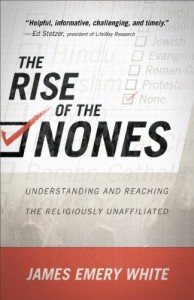
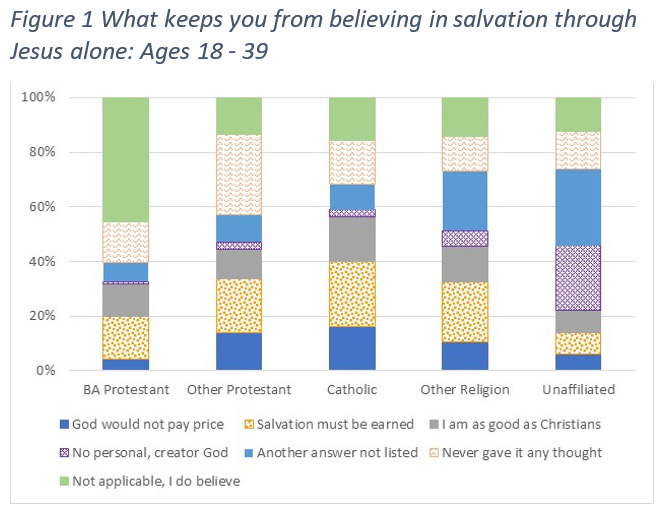
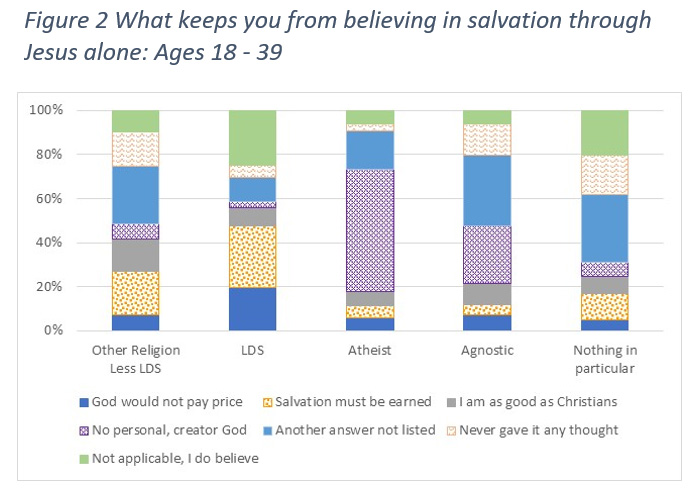 To get a better understanding of what drives these results, we dove further into the makeup of each of these two groups. The results are shown in Figure 2.
To get a better understanding of what drives these results, we dove further into the makeup of each of these two groups. The results are shown in Figure 2.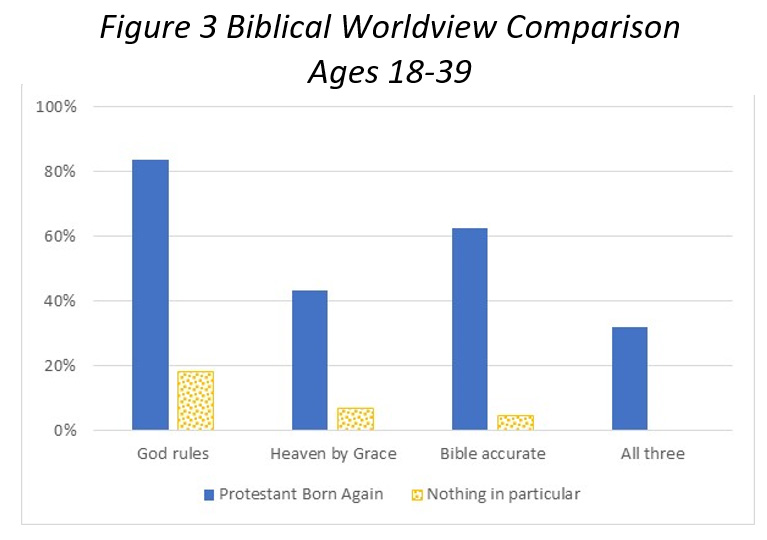 Let’s compare the results for Born-again Protestants and those who claimed to be Nothing in Particular. As shown in Figure 3, for each of the questions those agreeing with a biblical worldview among the Nothing in Particulars is a small fraction of those among Born-again Protestants. When we combine the three questions together, we see one out of three Born-again Protestants vs. no NIPs. Certainly, some of these NIPs came from an evangelical background, but none of them interviewed in our survey ascribe to a basic evangelical worldview as adults. As noted in our first report, one in three orn-again Protestants is a disappointing percentage ascribing to these biblical worldview questions, but it is certainly dramatically better than the Nothing in Particular group.
Let’s compare the results for Born-again Protestants and those who claimed to be Nothing in Particular. As shown in Figure 3, for each of the questions those agreeing with a biblical worldview among the Nothing in Particulars is a small fraction of those among Born-again Protestants. When we combine the three questions together, we see one out of three Born-again Protestants vs. no NIPs. Certainly, some of these NIPs came from an evangelical background, but none of them interviewed in our survey ascribe to a basic evangelical worldview as adults. As noted in our first report, one in three orn-again Protestants is a disappointing percentage ascribing to these biblical worldview questions, but it is certainly dramatically better than the Nothing in Particular group.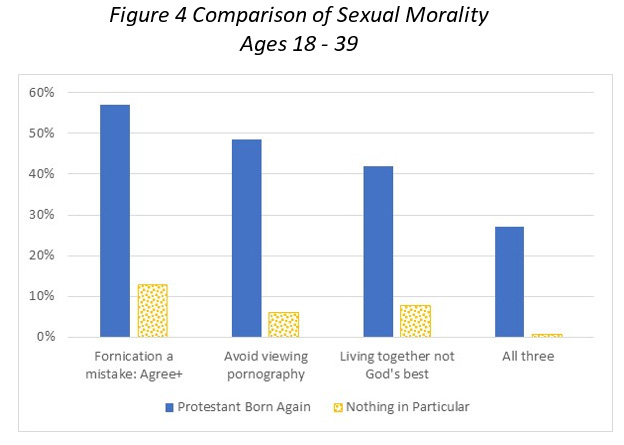 The results from our survey are shown in Figure 4. Once again, we see a large difference between these two groups. Clearly, the NIPs do not ascribe to a biblical view on sexual morality. The majority of Born-again Protestants do not ascribe to those beliefs either, but a significant minority of them do.
The results from our survey are shown in Figure 4. Once again, we see a large difference between these two groups. Clearly, the NIPs do not ascribe to a biblical view on sexual morality. The majority of Born-again Protestants do not ascribe to those beliefs either, but a significant minority of them do. Results from the first question are plotted in Figure 1. As shown, here and in the next three graphs, we will look at those ages 18 through 29 next to those ages 40 through 55 to see if there are differences based on age. If there is a trend or variation seen in the 30 through 39 age group, then that one is also shown as seen for Born Again Protestants in Figure 1.
Results from the first question are plotted in Figure 1. As shown, here and in the next three graphs, we will look at those ages 18 through 29 next to those ages 40 through 55 to see if there are differences based on age. If there is a trend or variation seen in the 30 through 39 age group, then that one is also shown as seen for Born Again Protestants in Figure 1. Pornography.
Pornography. The third question examines views on whether it is a good thing to live together in a sexual relationship before committing to marriage. The results are summarized in Figure 3. This is another question where Born Again Protestants show a significant difference based on age. The older group, 40 through 55, shows almost 60% who say that it should be avoided as instructed by God. The younger group, 18 through 29, shows only 40% with the same viewpoint. Across all age ranges only about one half of Born Again Protestants say that this practice should be avoided. So, even among this group, over half believe that it is okay and might be helpful.
The third question examines views on whether it is a good thing to live together in a sexual relationship before committing to marriage. The results are summarized in Figure 3. This is another question where Born Again Protestants show a significant difference based on age. The older group, 40 through 55, shows almost 60% who say that it should be avoided as instructed by God. The younger group, 18 through 29, shows only 40% with the same viewpoint. Across all age ranges only about one half of Born Again Protestants say that this practice should be avoided. So, even among this group, over half believe that it is okay and might be helpful. The verse above tells us two things. First, that someone who is given over to homosexual activity (like those given over to idolatry, sexual immorality, and greed) are not true followers of Christ. Even in Paul’s era, many were apparently saying they would inherit the kingdom of God and so Paul begins the statement by saying “Do not be deceived.” But it also clearly states that such a one can be washed, sanctified and justified in Jesus Christ. As Christians, we should love them and tell them the truth that God has a better way for their life.
The verse above tells us two things. First, that someone who is given over to homosexual activity (like those given over to idolatry, sexual immorality, and greed) are not true followers of Christ. Even in Paul’s era, many were apparently saying they would inherit the kingdom of God and so Paul begins the statement by saying “Do not be deceived.” But it also clearly states that such a one can be washed, sanctified and justified in Jesus Christ. As Christians, we should love them and tell them the truth that God has a better way for their life. Clearly, ones in the older group are more likely to take a biblical view on sexual behavior. In fact, on the far right, we see that those 40 to 55 are twice as likely as those 18 to 29 to hold to a biblical view. However, more important, is that over 80% of the younger ages and over 75% of the oldest ages do not hold to a biblical view on these combined topics regarding sexual behavior.
Clearly, ones in the older group are more likely to take a biblical view on sexual behavior. In fact, on the far right, we see that those 40 to 55 are twice as likely as those 18 to 29 to hold to a biblical view. However, more important, is that over 80% of the younger ages and over 75% of the oldest ages do not hold to a biblical view on these combined topics regarding sexual behavior. The first two answers are consistent with a Basic/Enhanced Biblical Worldview, reflecting 1) a view that their scripture is informed by a higher source of truth than simple science can draw upon, 2) a recognition that generally accepted scientific viewpoints have often changed over time, and 3) on the type of scientific questions being addressed here, there are in most cases a variety of theories supported by different groups of scientists. The second answer includes the possibility that the person’s holy scriptures do not directly address the topic at hand, but that some religious leaders have inferred a position on the topic from their interpretation of scriptures.
The first two answers are consistent with a Basic/Enhanced Biblical Worldview, reflecting 1) a view that their scripture is informed by a higher source of truth than simple science can draw upon, 2) a recognition that generally accepted scientific viewpoints have often changed over time, and 3) on the type of scientific questions being addressed here, there are in most cases a variety of theories supported by different groups of scientists. The second answer includes the possibility that the person’s holy scriptures do not directly address the topic at hand, but that some religious leaders have inferred a position on the topic from their interpretation of scriptures. Note these answers follow a similar pattern to those of the first question, but now they are applied to a specific question where many people assume there is no meeting ground between science and religion.
Note these answers follow a similar pattern to those of the first question, but now they are applied to a specific question where many people assume there is no meeting ground between science and religion. First note that if we strictly define real scientists as individuals meeting these qualifications—1) a Ph.D. in a scientific field, 2) actively involved in the field, and 3) published in reputable scientific journals—we will find many scientists who agree that there are other sources of truth outside of science. So, we can say with confidence that the statement in question #3 is objectively, verifiably not true. However, there are certainly some believers in scientism [the belief that science is the only way to know ultimate truth] who claim the statement is true. They accomplish this trick by claiming that anyone who does not believe that science is the only source of real truth cannot by definition be a real scientist.
First note that if we strictly define real scientists as individuals meeting these qualifications—1) a Ph.D. in a scientific field, 2) actively involved in the field, and 3) published in reputable scientific journals—we will find many scientists who agree that there are other sources of truth outside of science. So, we can say with confidence that the statement in question #3 is objectively, verifiably not true. However, there are certainly some believers in scientism [the belief that science is the only way to know ultimate truth] who claim the statement is true. They accomplish this trick by claiming that anyone who does not believe that science is the only source of real truth cannot by definition be a real scientist. What do the results look like when we combine these questions? In our opinion, there are a number of different answers that could be consistent with a biblical worldview. Starting with the strictest view of relying on the Bible rather than science and then adding in those who would look at the results from science to obtain a clearer understanding of what the Bible teaches or those areas where the Bible is silent. Then, we add in their view on scientism which as already discussed is demonstrated by a long list of scientists who disagree to be false, thus being a source of strong disagreement.
What do the results look like when we combine these questions? In our opinion, there are a number of different answers that could be consistent with a biblical worldview. Starting with the strictest view of relying on the Bible rather than science and then adding in those who would look at the results from science to obtain a clearer understanding of what the Bible teaches or those areas where the Bible is silent. Then, we add in their view on scientism which as already discussed is demonstrated by a long list of scientists who disagree to be false, thus being a source of strong disagreement. A natural question to ask is, “Does having a Basic Biblical Worldview correlate with having a biblical view on these science issues?” We can look at this question by comparing Born Again Protestants with a Basic Biblical Worldview with Born Again Protestants without a Basic BWV. The results are shown in the adjacent figure.
A natural question to ask is, “Does having a Basic Biblical Worldview correlate with having a biblical view on these science issues?” We can look at this question by comparing Born Again Protestants with a Basic Biblical Worldview with Born Again Protestants without a Basic BWV. The results are shown in the adjacent figure.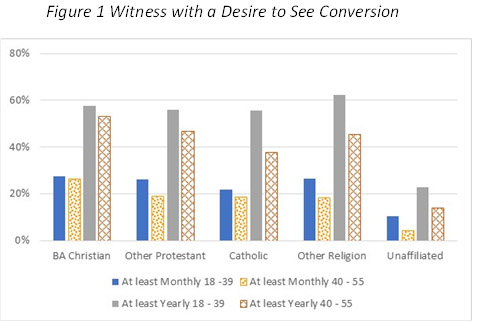 Looking at the detailed results, all religions except the Unaffiliated showed very similar results: over 20% (1 in 5) of those witnessed at least monthly and about half witnessed at least yearly. So, it would appear that there is a lot of witnessing going on with very few conversions.
Looking at the detailed results, all religions except the Unaffiliated showed very similar results: over 20% (1 in 5) of those witnessed at least monthly and about half witnessed at least yearly. So, it would appear that there is a lot of witnessing going on with very few conversions.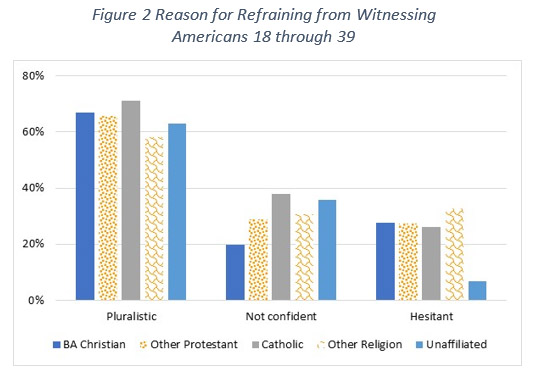 We also asked the question: “When I refrain from communicating my religious belief with someone, it’s usually because:”
We also asked the question: “When I refrain from communicating my religious belief with someone, it’s usually because:”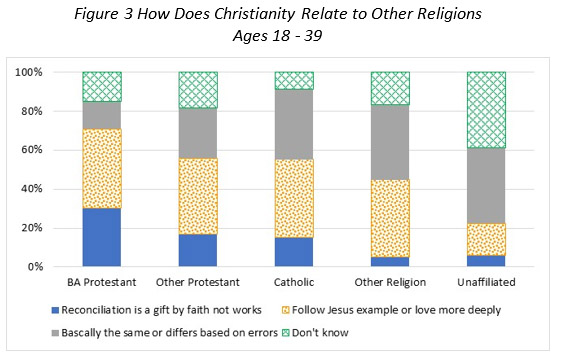 The results are charted in the graph to the right. First, notice the interesting result that only about 30% of Born Again Protestants selected ‘reconciliation is a gift’ while 40% selected following Jesus’ example or love others more deeply. As noted above, this second answer is not inconsistent with the concepts of Christianity but is not as fundamental as the first. However, selecting this answer over reconciliation is a gift’ is consistent with what we saw earlier: 70% of Born Again Christians are not exclusivists.
The results are charted in the graph to the right. First, notice the interesting result that only about 30% of Born Again Protestants selected ‘reconciliation is a gift’ while 40% selected following Jesus’ example or love others more deeply. As noted above, this second answer is not inconsistent with the concepts of Christianity but is not as fundamental as the first. However, selecting this answer over reconciliation is a gift’ is consistent with what we saw earlier: 70% of Born Again Christians are not exclusivists.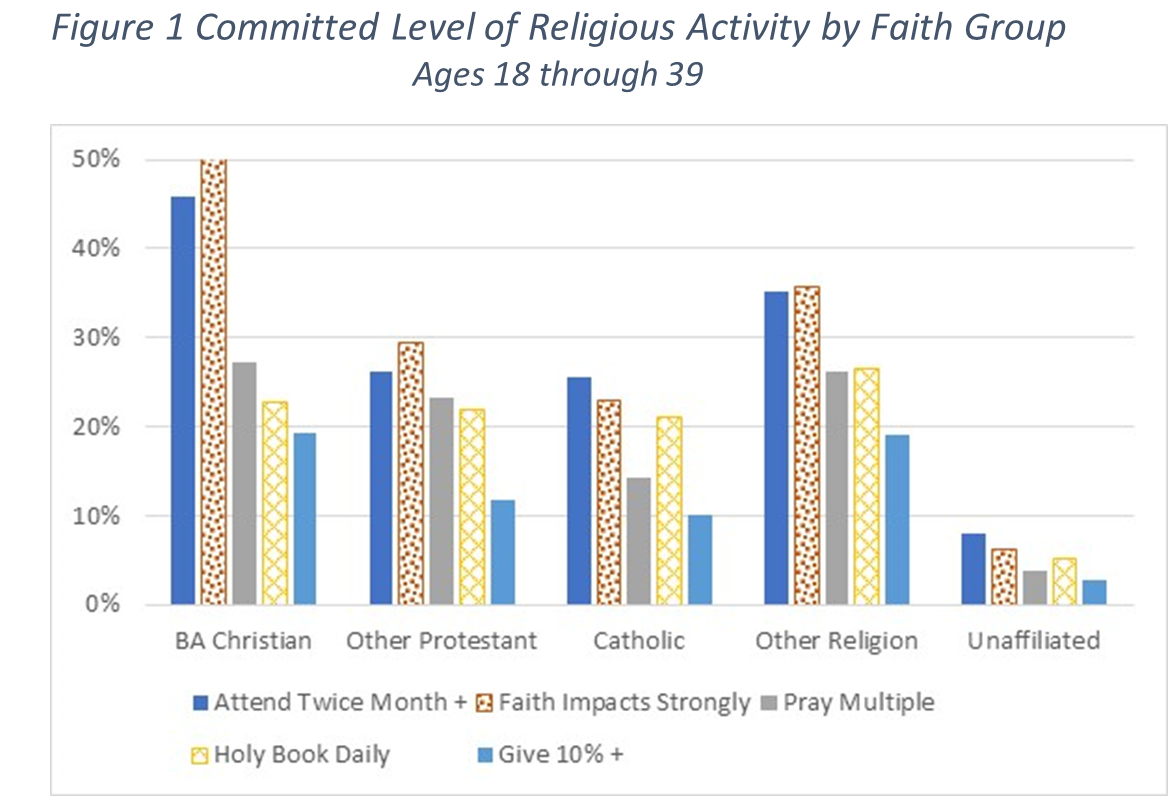
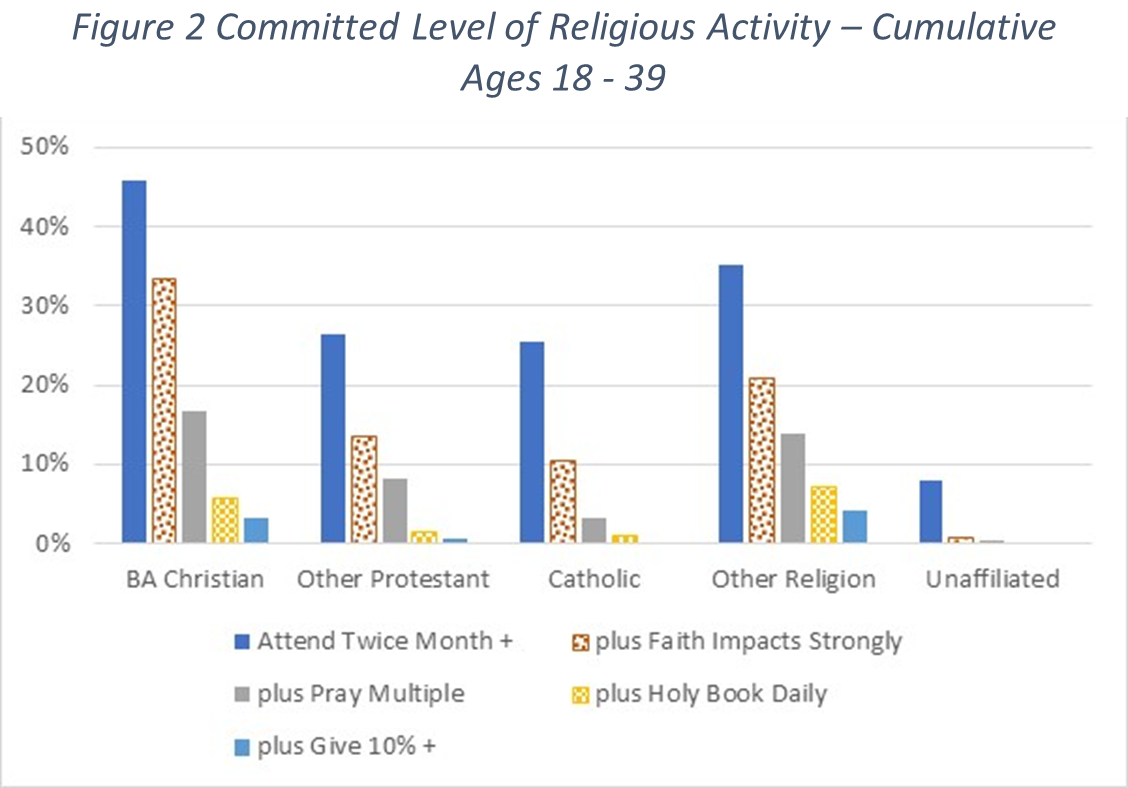
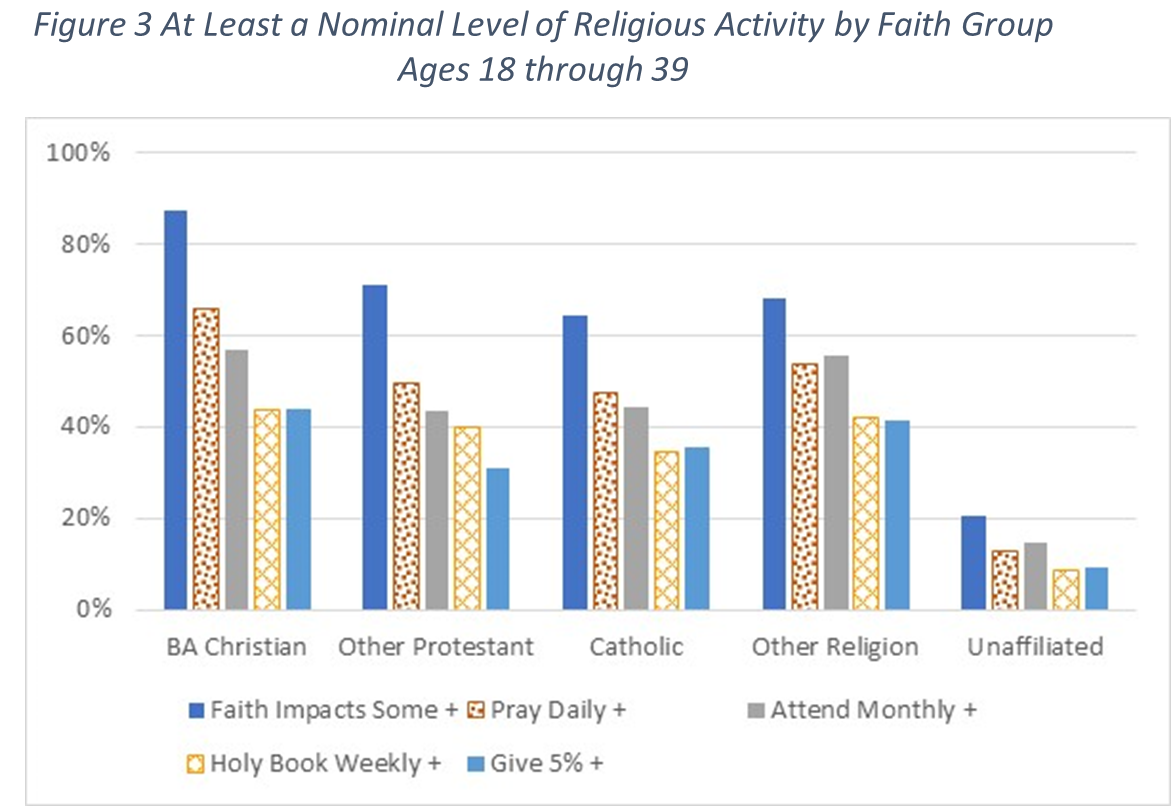 Nominal or Committed Levels of Religious Activity
Nominal or Committed Levels of Religious Activity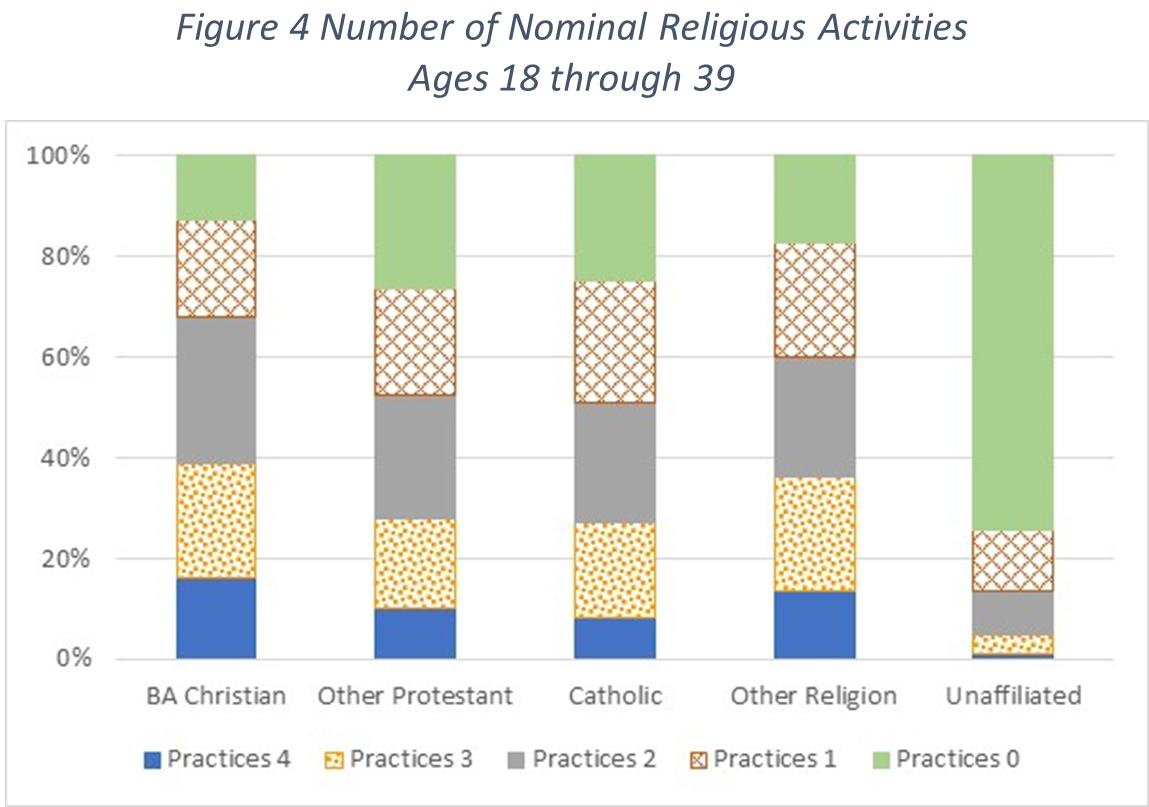
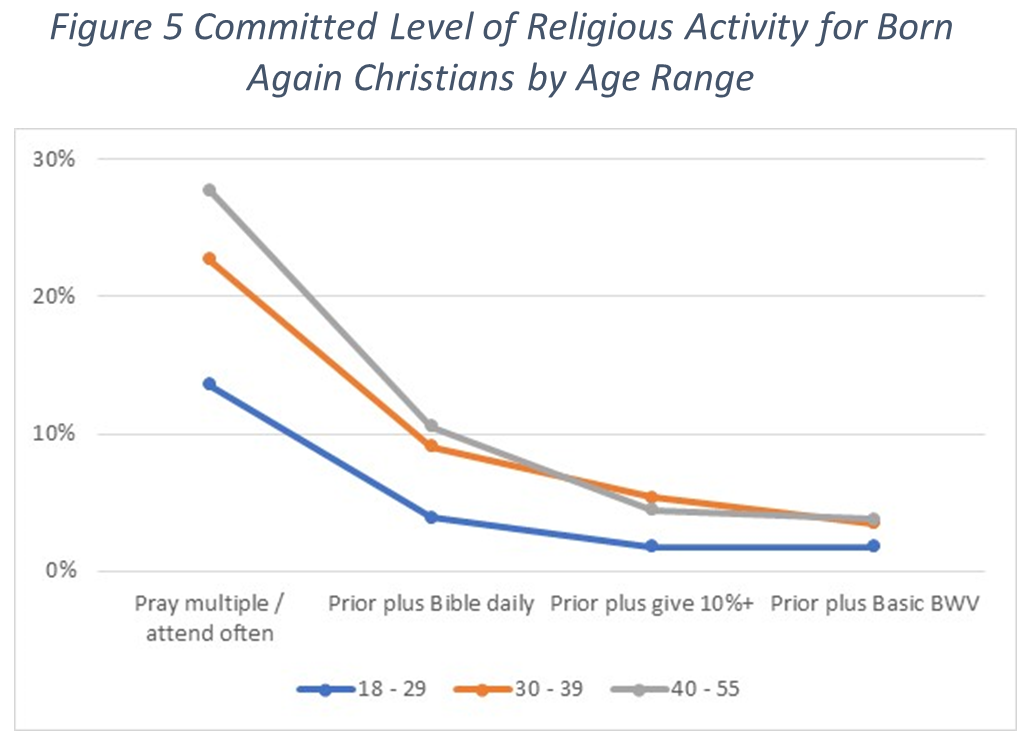
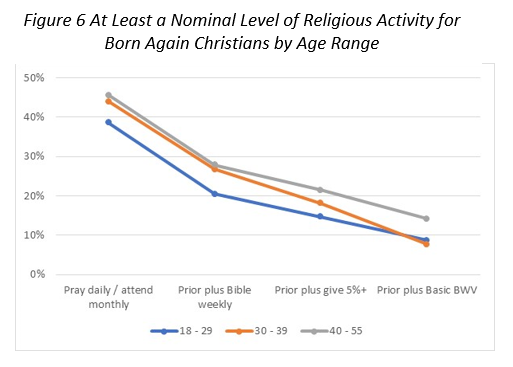
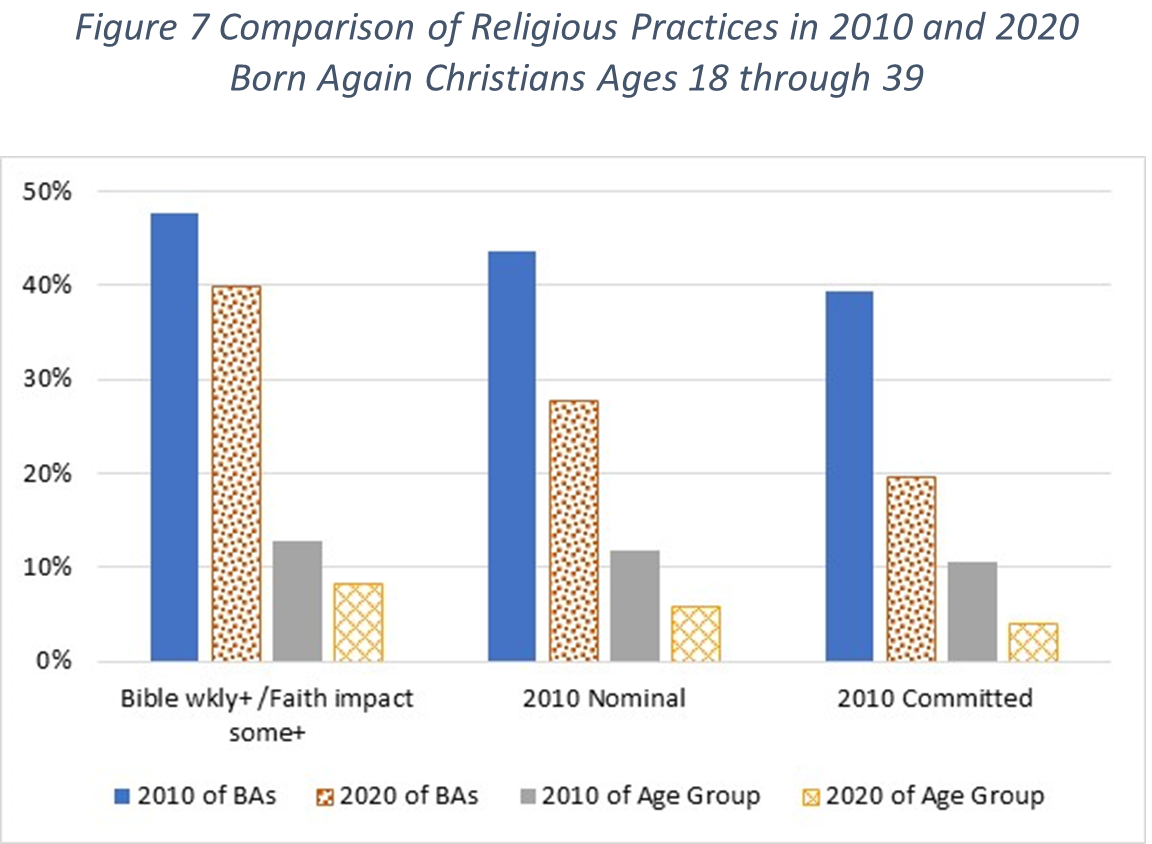
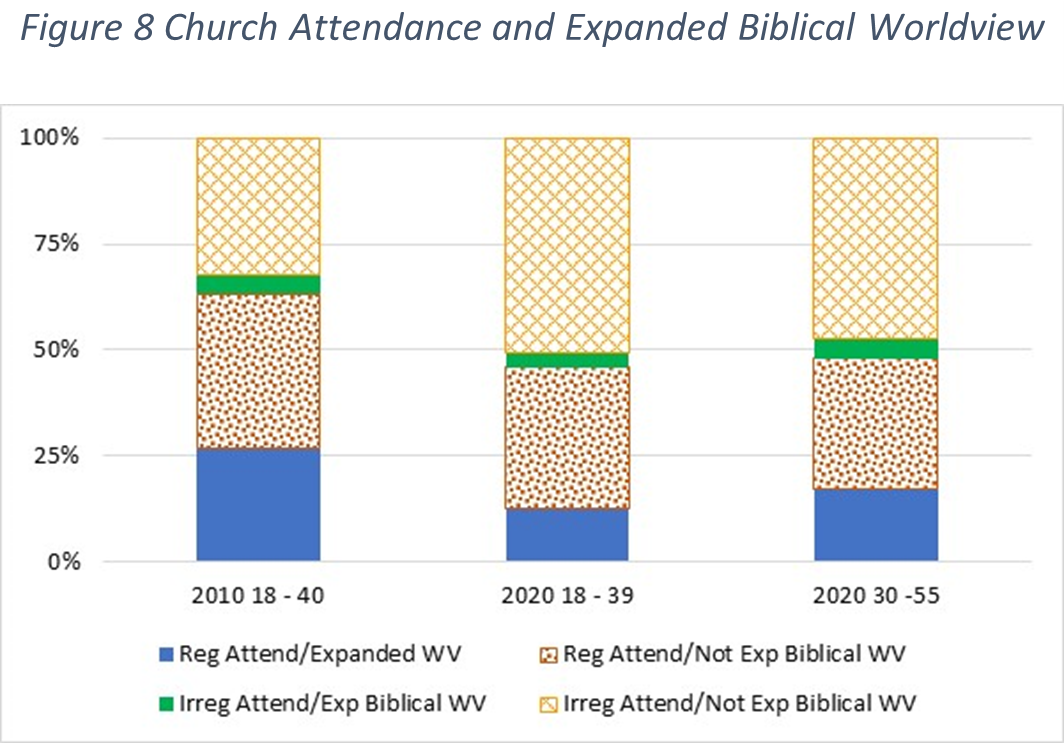 The figure on the left compares the findings from 2010 with those from 2020 using the more stringent Expanded Biblical Worldview. The values shown are the percent of Born-Again Christians (so all columns add up to 100% even though the percentage of Born Again Christians is less in 2020). Two age ranges are used in 2020; the first one is basically the same age range used in 2010 (18 – 39) and the second age range (30 – 55) is very close to the age range of the 2010 survey aged by the ten years that have gone by.
The figure on the left compares the findings from 2010 with those from 2020 using the more stringent Expanded Biblical Worldview. The values shown are the percent of Born-Again Christians (so all columns add up to 100% even though the percentage of Born Again Christians is less in 2020). Two age ranges are used in 2020; the first one is basically the same age range used in 2010 (18 – 39) and the second age range (30 – 55) is very close to the age range of the 2010 survey aged by the ten years that have gone by.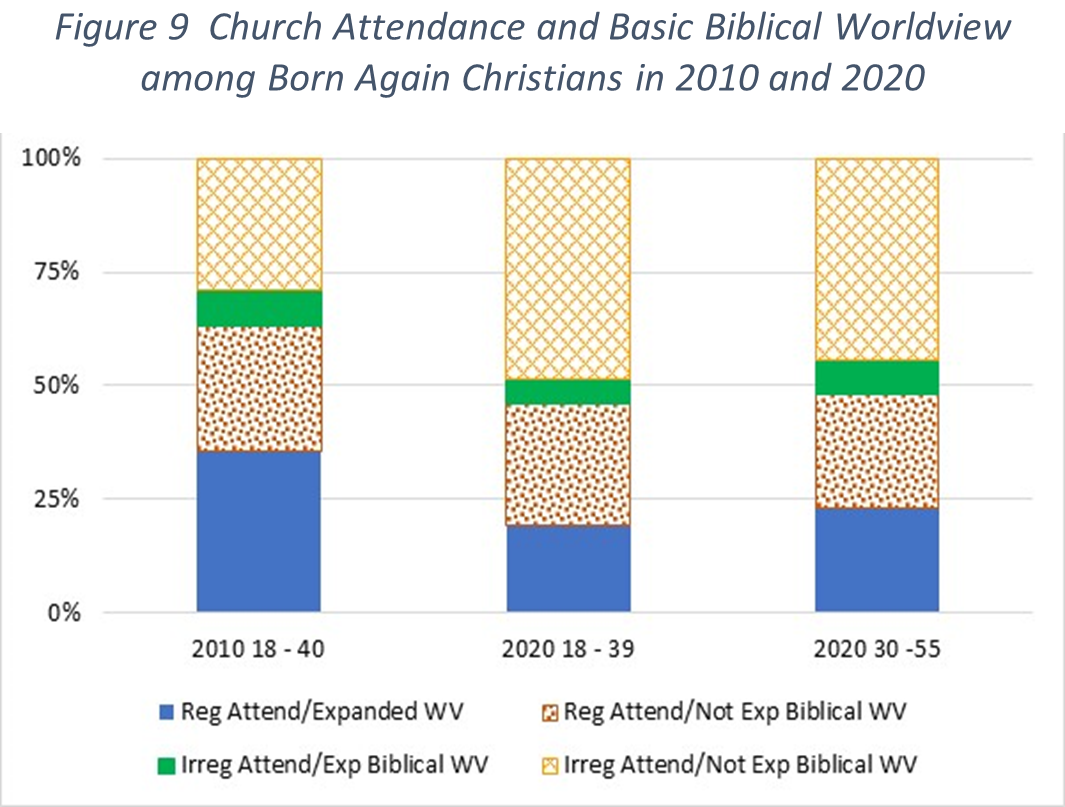 Now let’s examine the same chart using a Basic Biblical Worldview. We see nearly the same features as discussed above. A significant drop is shown in those with regular attendance and a Basic Biblical Worldview coupled with a significant increase in those with irregular attendance and no Basic Biblical Worldview.
Now let’s examine the same chart using a Basic Biblical Worldview. We see nearly the same features as discussed above. A significant drop is shown in those with regular attendance and a Basic Biblical Worldview coupled with a significant increase in those with irregular attendance and no Basic Biblical Worldview.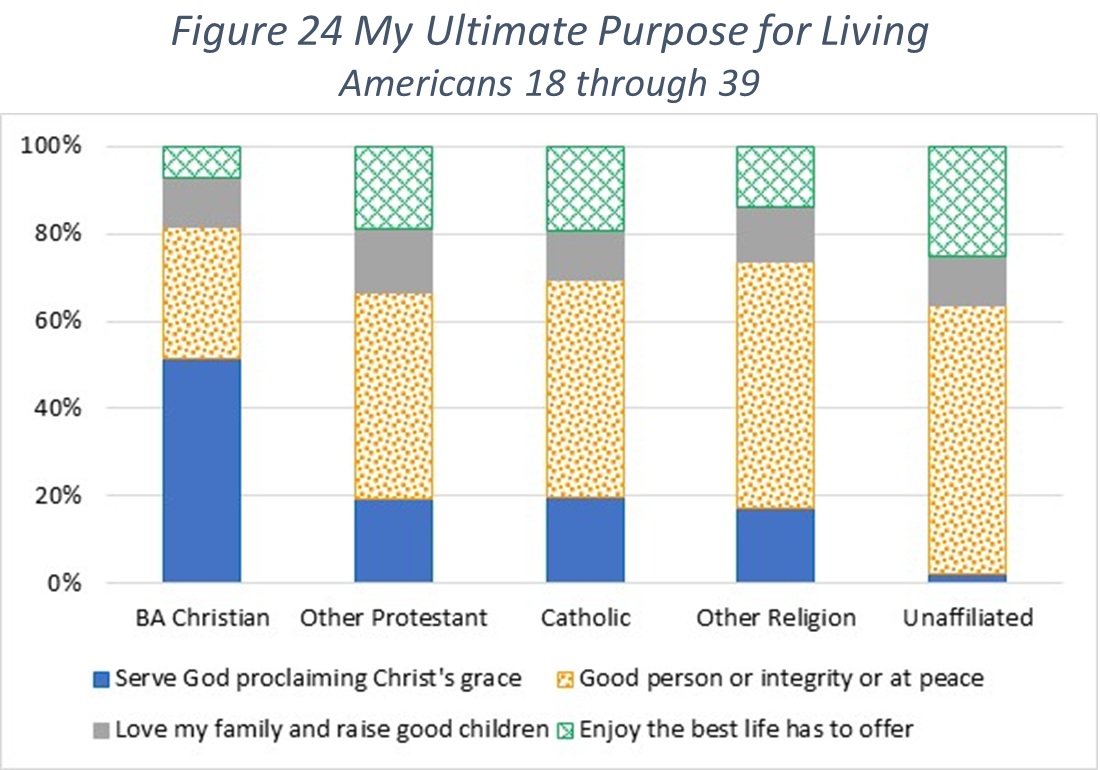 The results are charted in the graph to the left. As shown, just over half of Born Again Christians profess an eternal perspective. This means almost half do not, with most of those selecting a purpose that focuses on good behaviors in their personal life.
The results are charted in the graph to the left. As shown, just over half of Born Again Christians profess an eternal perspective. This means almost half do not, with most of those selecting a purpose that focuses on good behaviors in their personal life.